FIAT 127 1973 1.G User Guide
Manufacturer: FIAT, Model Year: 1973, Model line: 127, Model: FIAT 127 1973 1.GPages: 34, PDF Size: 6.87 MB
Page 11 of 34
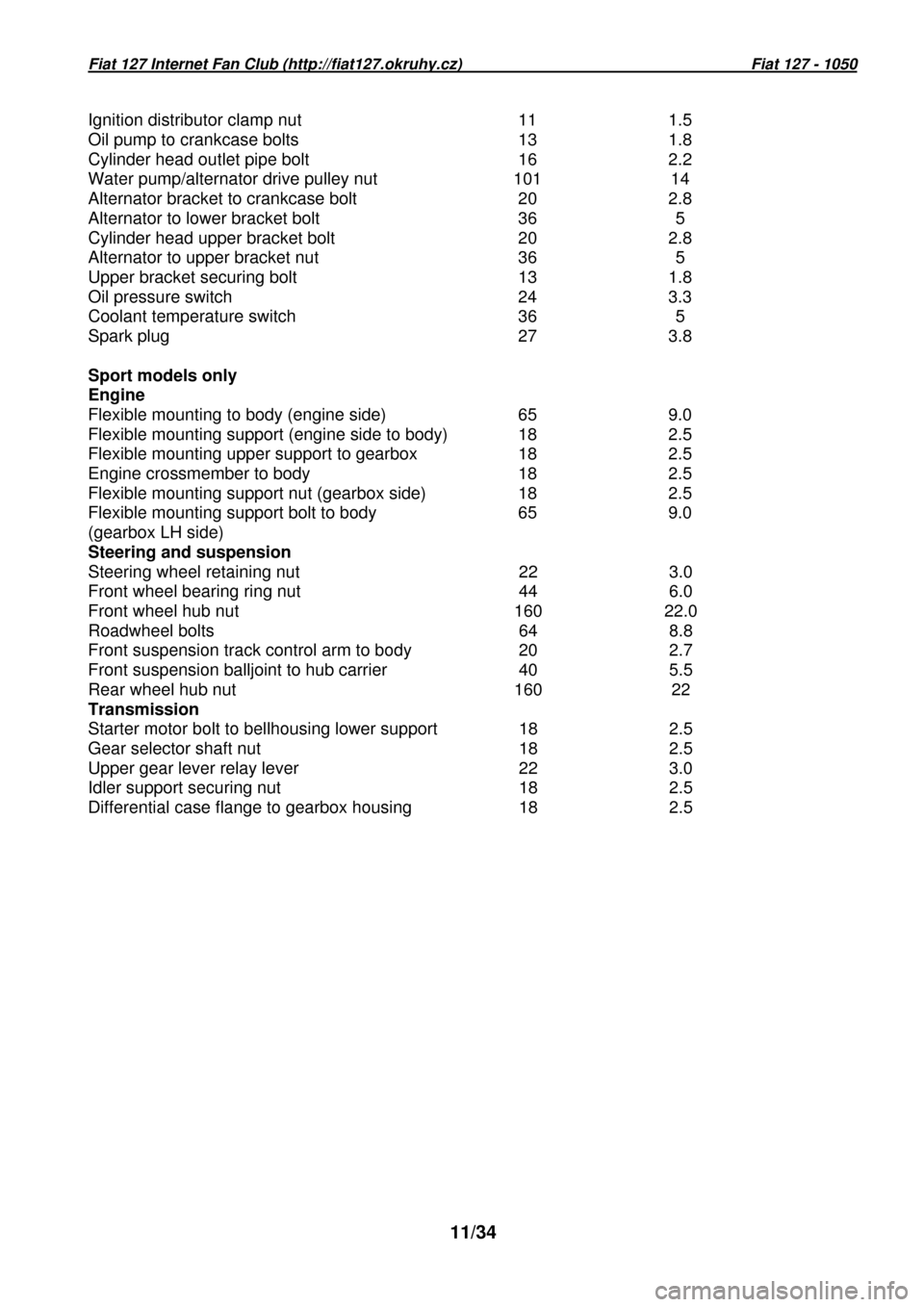
Fiat 127 Internet Fan Club (http://fiat127.okruhy.cz) Fiat 127 - 1050
11/34
Ignition distributor clamp nut 11 1.5
Oil pump to crankcase bolts 13 1.8
Cylinder head outlet pipe bolt 16 2.2
Water pump/alternator drive pulley nut 101 14
Alternator bracket to crankcase bolt 20 2.8
Alternator to lower bracket bolt 36 5
Cylinder head upper bracket bolt 20 2.8
Alternator to upper bracket nut 36 5
Upper bracket securing bolt 13 1.8
Oil pressure switch 24 3.3
Coolant temperature switch 36 5
Spark plug 27 3.8
Sport models only
Engine
Flexible mounting to body (engine side) 65 9.0
Flexible mounting support (engine side to body)
18 2.5
Flexible mounting upper support to gearbox 18 2.5
Engine crossmember to body 18 2.5
Flexible mounting support nut (gearbox side) 18 2.5
Flexible mounting support bolt to body
(gearbox LH side) 65 9.0
Steering and suspension
Steering wheel retaining nut 22 3.0
Front wheel bearing ring nut 44 6.0
Front wheel hub nut 160 22.0
Roadwheel bolts 64 8.8
Front suspension track control arm to body 20 2.7
Front suspension balljoint to hub carrier 40 5.5
Rear wheel hub nut 160 22
Transmission
Starter motor bolt to bellhousing lower support 18 2.5
Gear selector shaft nut 18 2.5
Upper gear lever relay lever 22 3.0
Idler support securing nut 18 2.5
Differential case flange to gearbox housing 18 2.5
Page 12 of 34
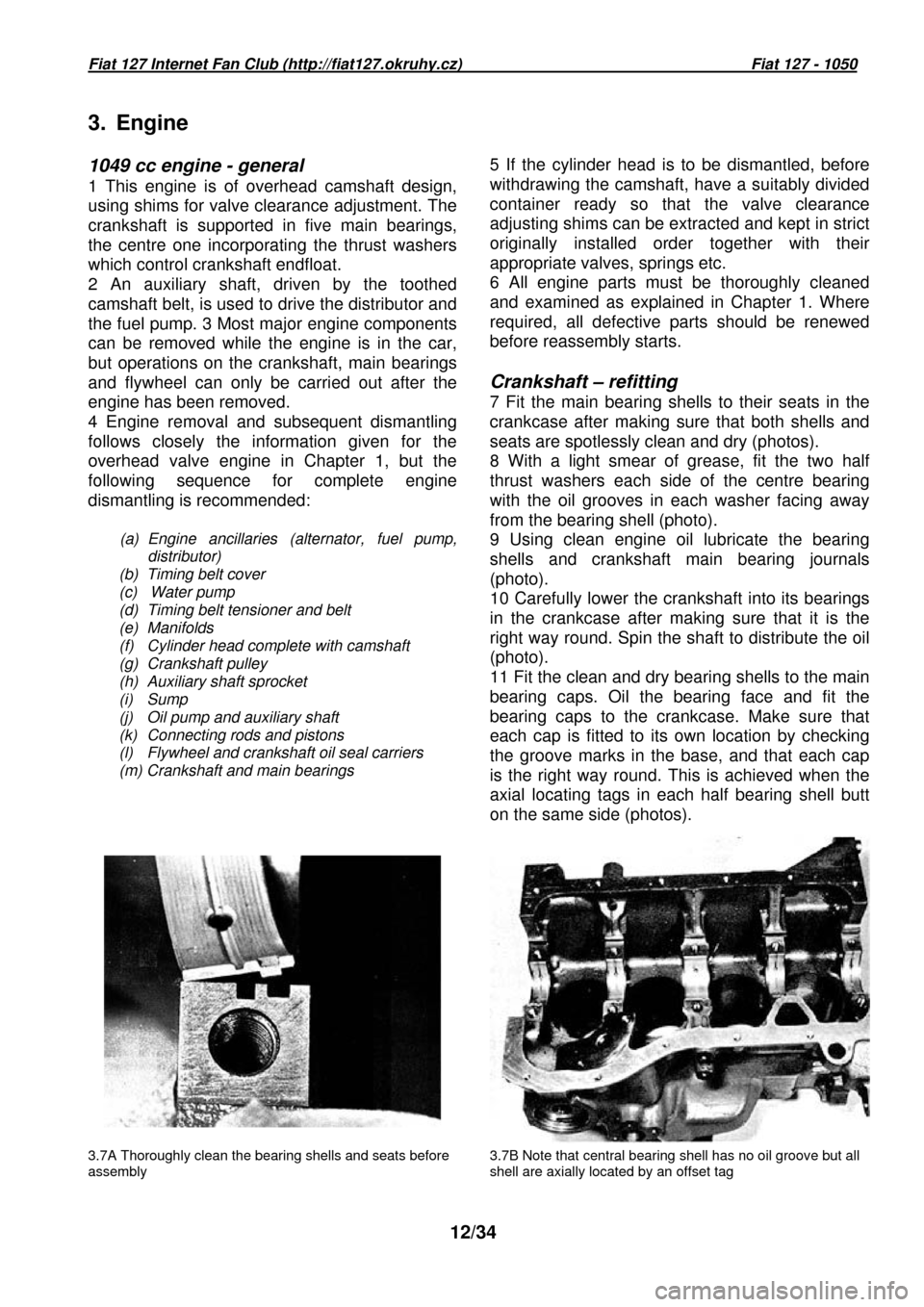
Fiat 127 Internet Fan Club (http://fiat127.okruhy.cz) Fiat 127 - 1050
12/34
3. Engine
1049 cc engine - general
1 This engine is of overhead camshaft design,
using shims for valve clearance adjustment. The
crankshaft is supported in five main bearings,
the centre one incorporating the thrust washers
which control crankshaft endfloat.
2 An auxiliary shaft, driven by the toothed
camshaft belt, is used to drive the distributor and
the fuel pump. 3 Most major engine components
can be removed while the engine is in the car,
but operations on the crankshaft, main bearings
and flywheel can only be carried out after the
engine has been removed.
4 Engine removal and subsequent dismantling
follows closely the information given for the
overhead valve engine in Chapter 1, but the
following sequence for complete engine
dismantling is recommended:
(a) Engine ancillaries (alternator, fuel pump, distributor)
(b) Timing belt cover
(c) Water pump
(d) Timing belt tensioner and belt
(e) Manifolds
(f) Cylinder head complete with camshaft
(g) Crankshaft pulley
(h) Auxiliary shaft sprocket
(i) Sump
(j) Oil pump and auxiliary shaft
(k) Connecting rods and pistons
(l) Flywheel and crankshaft oil seal carriers
(m) Crankshaft and main bearings
5 If the cylinder head is to be dismantled, before
withdrawing the camshaft, have a suitably divided
container ready so that the valve clearance
adjusting shims can be extracted and kept in strict
originally installed order together with their
appropriate valves, springs etc.
6 All engine parts must be thoroughly cleaned
and examined as explained in Chapter 1. Where
required, all defective parts should be renewed
before reassembly starts.
Crankshaft – refitting
7 Fit the main bearing shells to their seats in the
crankcase after making sure that both shells and
seats are spotlessly clean and dry (photos).
8 With a light smear of grease, fit the two half
thrust washers each side of the centre bearing
with the oil grooves in each washer facing away
from the bearing shell (photo).
9 Using clean engine oil lubricate the bearing
shells and crankshaft main bearing journals
(photo).
10 Carefully lower the crankshaft into its bearings
in the crankcase after making sure that it is the
right way round. Spin the shaft to distribute the o il
(photo).
11 Fit the clean and dry bearing shells to the main
bearing caps. Oil the bearing face and fit the
bearing caps to the crankcase. Make sure that
each cap is fitted to its own location by checking
the groove marks in the base, and that each cap
is the right way round. This is achieved when the
axial locating tags in each half bearing shell butt
on the same side (photos).
3.7A Thoroughly clean the bearing shells and seats
before
assembly 3.7B Note that central bearing shell has no oil gro ove but all
shell are axially located by an offset tag
Page 13 of 34
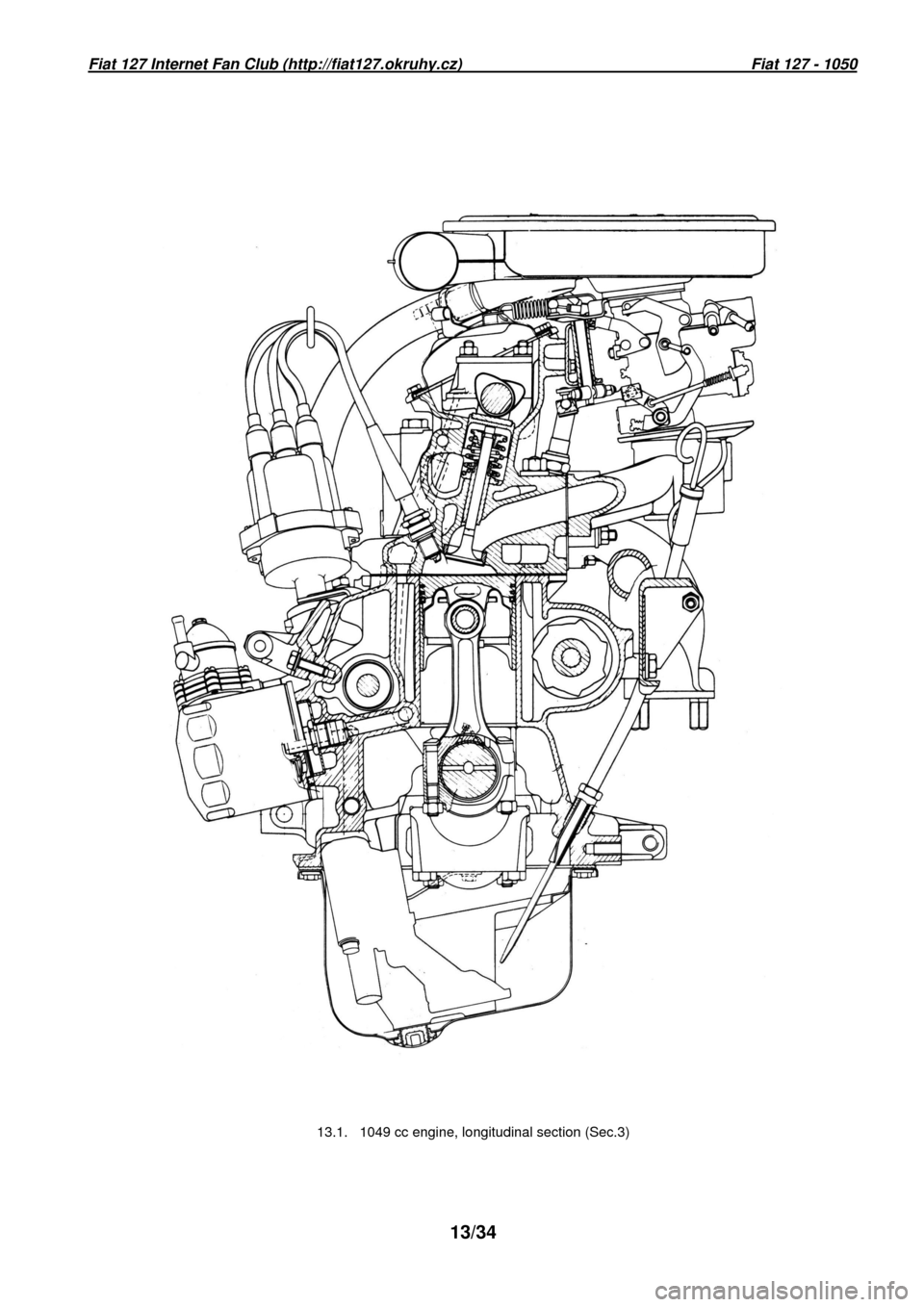
Fiat 127 Internet Fan Club (http://fiat127.okruhy.cz) Fiat 127 - 1050
13/34
13.1. 1049 cc engine, longitudinal section (Sec.3 )
Page 14 of 34
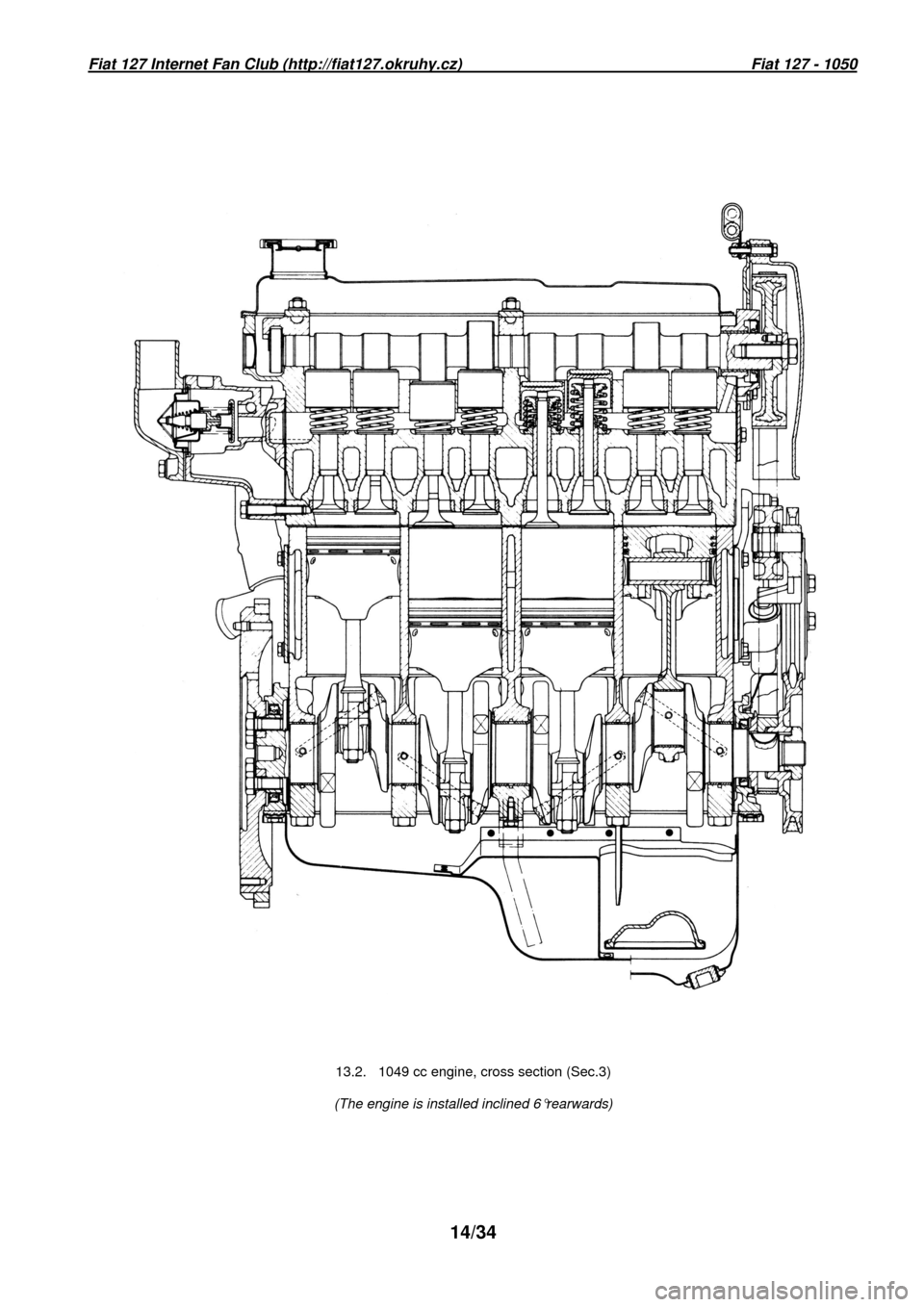
Fiat 127 Internet Fan Club (http://fiat127.okruhy.cz) Fiat 127 - 1050
14/34
13.2. 1049 cc engine, cross section (Sec.3)
(The engine is installed inclined 6°rearwards)
Page 15 of 34
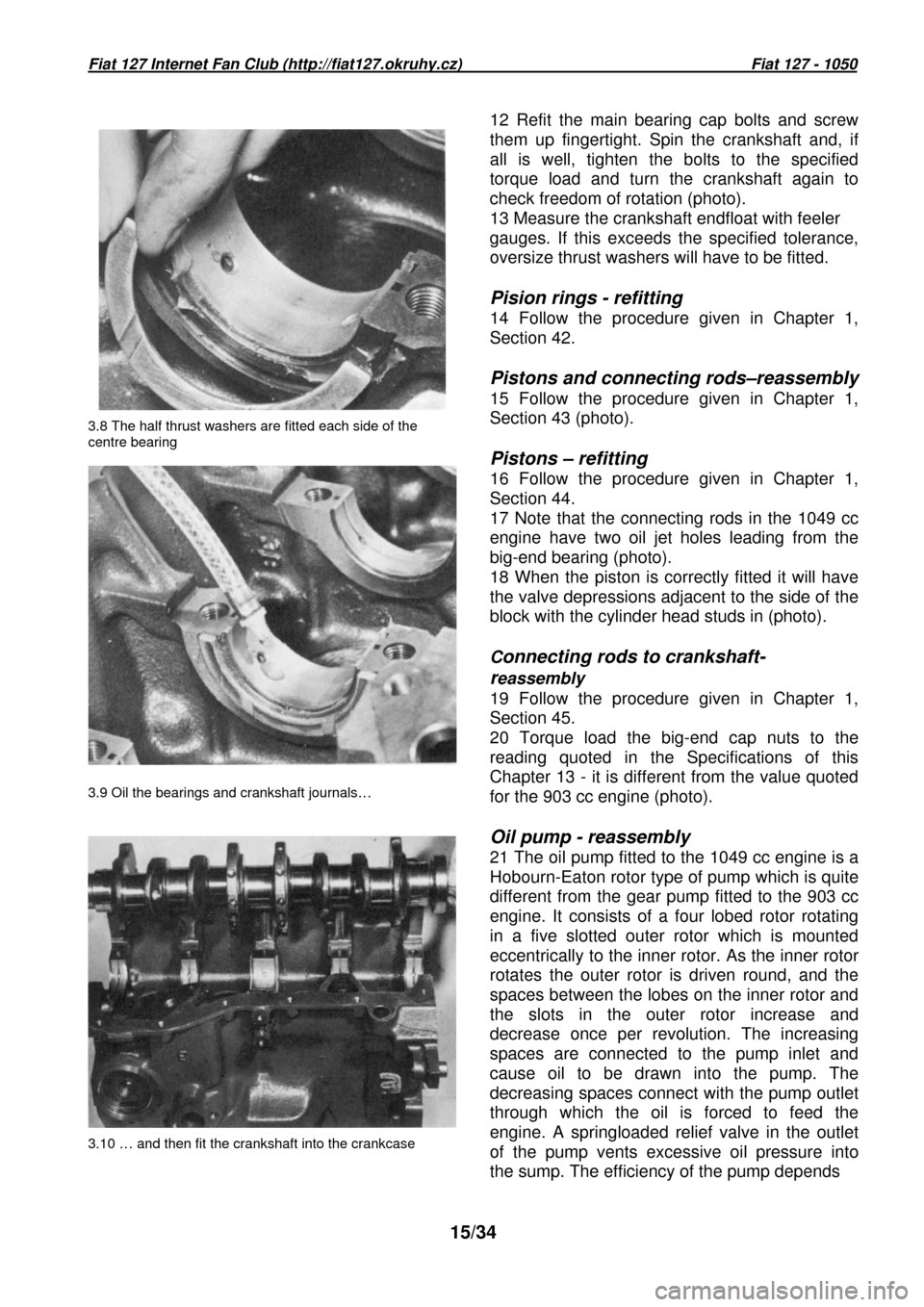
Fiat 127 Internet Fan Club (http://fiat127.okruhy.cz) Fiat 127 - 1050
15/34
3.8 The half thrust washers are fitted each side of
the
centre bearing
3.9 Oil the bearings and crankshaft journals…
3.10 … and then fit the crankshaft into the crankca se 12 Refit the main bearing cap bolts and screw
them up fingertight. Spin the crankshaft and, if
all is well, tighten the bolts to the specified
torque load and turn the crankshaft again to
check freedom of rotation (photo).
13 Measure the crankshaft endfloat with feeler
gauges. If this exceeds the specified tolerance,
oversize thrust washers will have to be fitted.
Pision rings - refitting
14 Follow the procedure given in Chapter 1,
Section 42.
Pistons and connecting rods–reassembly
15 Follow the procedure given in Chapter 1,
Section 43 (photo).
Pistons – refitting
16 Follow the procedure given in Chapter 1,
Section 44.
17 Note that the connecting rods in the 1049 cc
engine have two oil jet holes leading from the
big-end bearing (photo).
18 When the piston is correctly fitted it will have
the valve depressions adjacent to the side of the
block with the cylinder head studs in (photo). C
onnecting rods to crankshaft-
r
eassembly
19 Follow the procedure given in Chapter 1,
Section 45.
20 Torque load the big-end cap nuts to the
reading quoted in the Specifications of this
Chapter 13 - it is different from the value quoted
for the 903 cc engine (photo).
Oil pump - reassembly
21 The oil pump fitted to the 1049 cc engine is a
Hobourn-Eaton rotor type of pump which is quite
different from the gear pump fitted to the 903 cc
engine. It consists of a four lobed rotor rotating
in a five slotted outer rotor which is mounted
eccentrically to the inner rotor. As the inner roto r
rotates the outer rotor is driven round, and the
spaces between the lobes on the inner rotor and
the slots in the outer rotor increase and
decrease once per revolution. The increasing
spaces are connected to the pump inlet and
cause oil to be drawn into the pump. The
decreasing spaces connect with the pump outlet
through which the oil is forced to feed the
engine. A springloaded relief valve in the outlet
of the pump vents excessive oil pressure into
the sump. The efficiency of the pump depends
Page 16 of 34
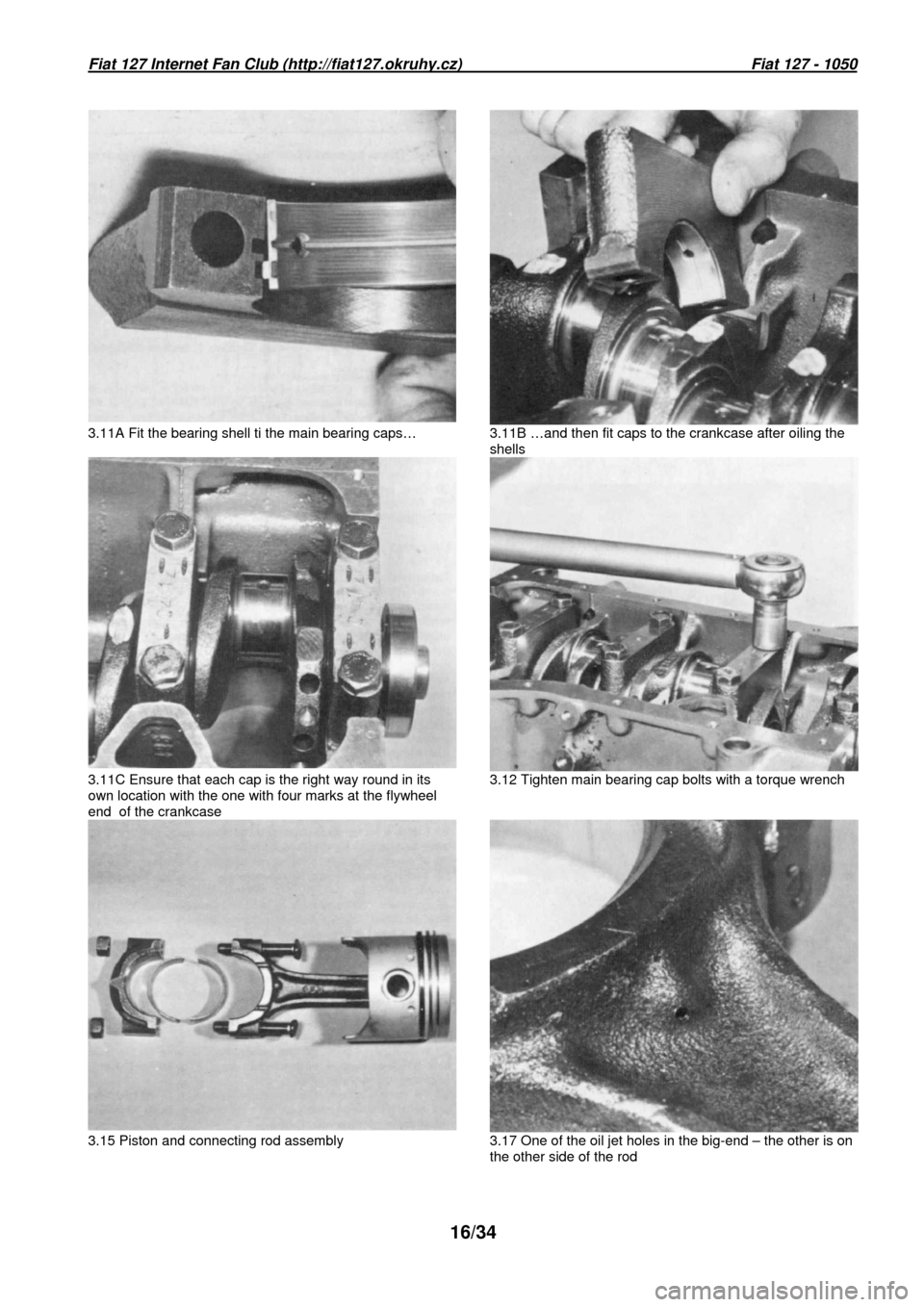
Fiat 127 Internet Fan Club (http://fiat127.okruhy.cz) Fiat 127 - 1050
16/34
3.11A Fit the bearing shell ti the main bearing cap s… 3.11B …and then fit caps to the crankcase after oil ing the
shells
3.11C Ensure that each cap is the right way round i n its
own location with the one with four marks at the fl ywheel
end of the crankcase 3.12 Tighten main bearing cap bolts with a torque w rench
3.15 Piston and connecting rod assembly 3.17 One of the oil jet holes in the big-end – the other is on
the other side of the rod
Page 17 of 34
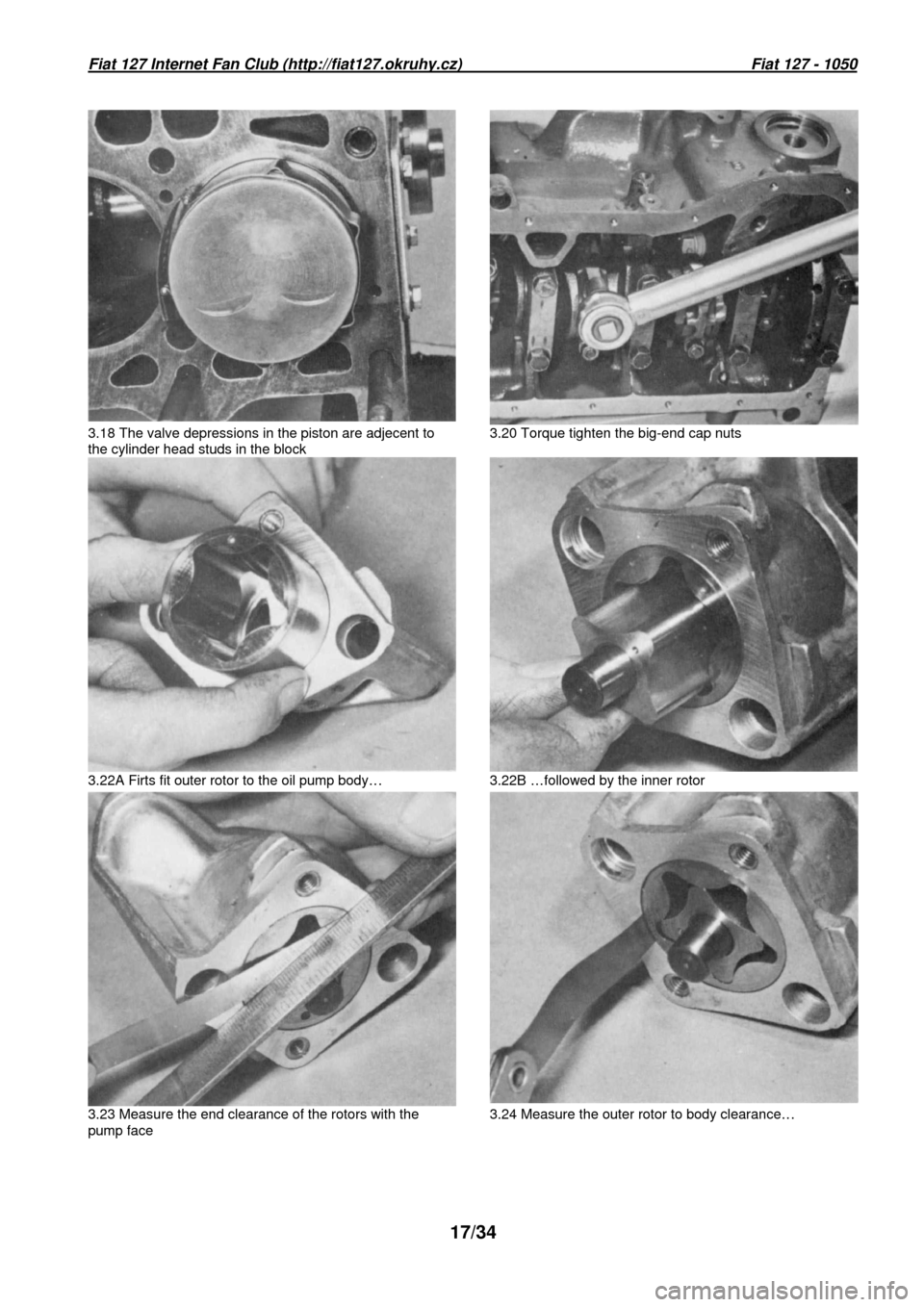
Fiat 127 Internet Fan Club (http://fiat127.okruhy.cz) Fiat 127 - 1050
17/34
3.18 The valve depressions in the piston are adjece nt to
the cylinder head studs in the block 3.20 Torque tighten the big-end cap nuts
3.22A Firts fit outer rotor to the oil pump body… 3.22B …followed by the inner rotor
3.23 Measure the end clearance of the rotors with t he
pump face 3.24 Measure the outer rotor to body clearance…
Page 18 of 34
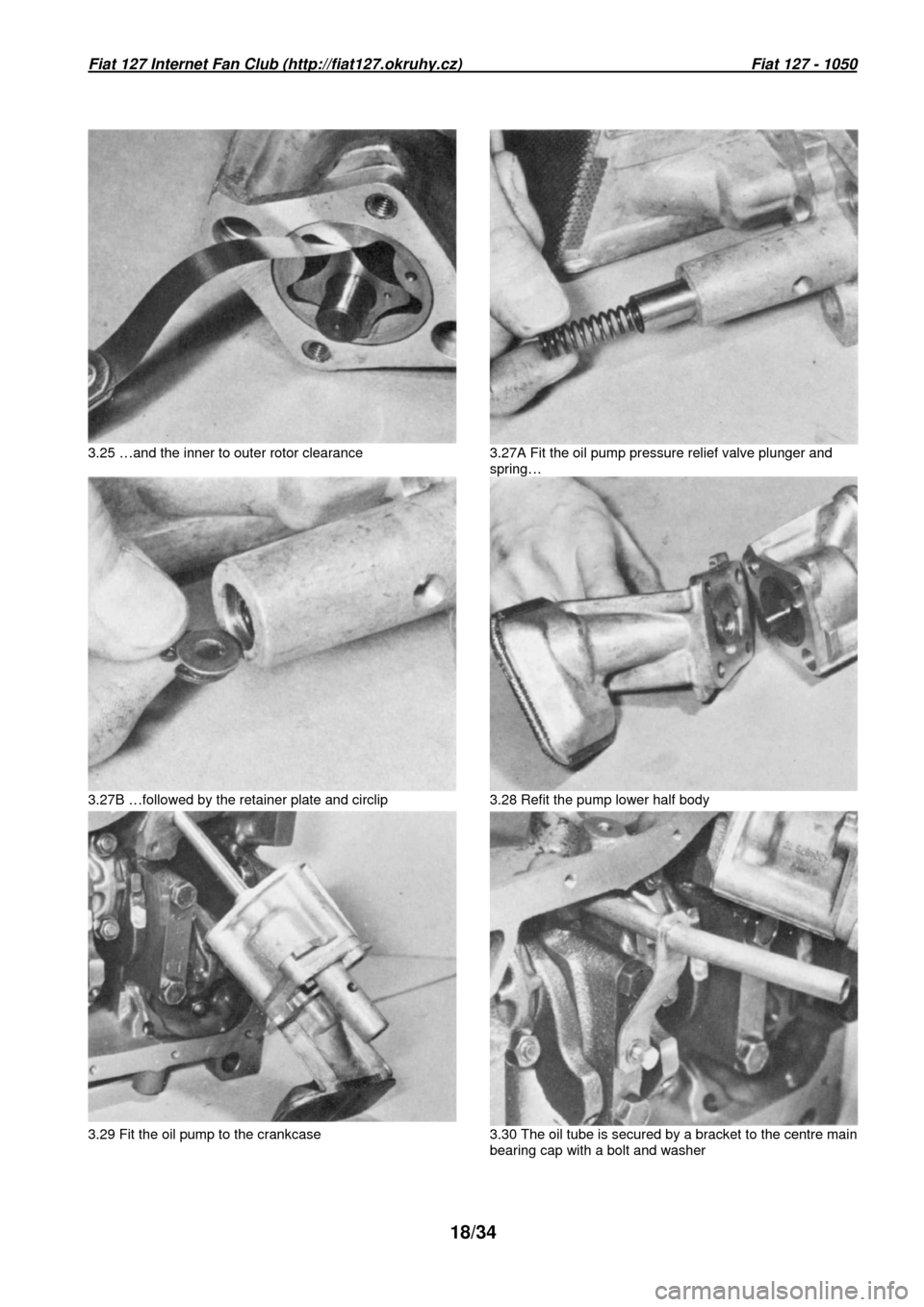
Fiat 127 Internet Fan Club (http://fiat127.okruhy.cz) Fiat 127 - 1050
18/34
3.25 …and the inner to outer rotor clearance 3.27A Fit the oil pump pressure relief valve plunge r and
spring…
3.27B …followed by the retainer plate and circlip 3.28 Refit the pump lower half body
3.29 Fit the oil pump to the crankcase 3.30 The oil tube is secured by a bracket to the ce ntre main
bearing cap with a bolt and washer
Page 19 of 34
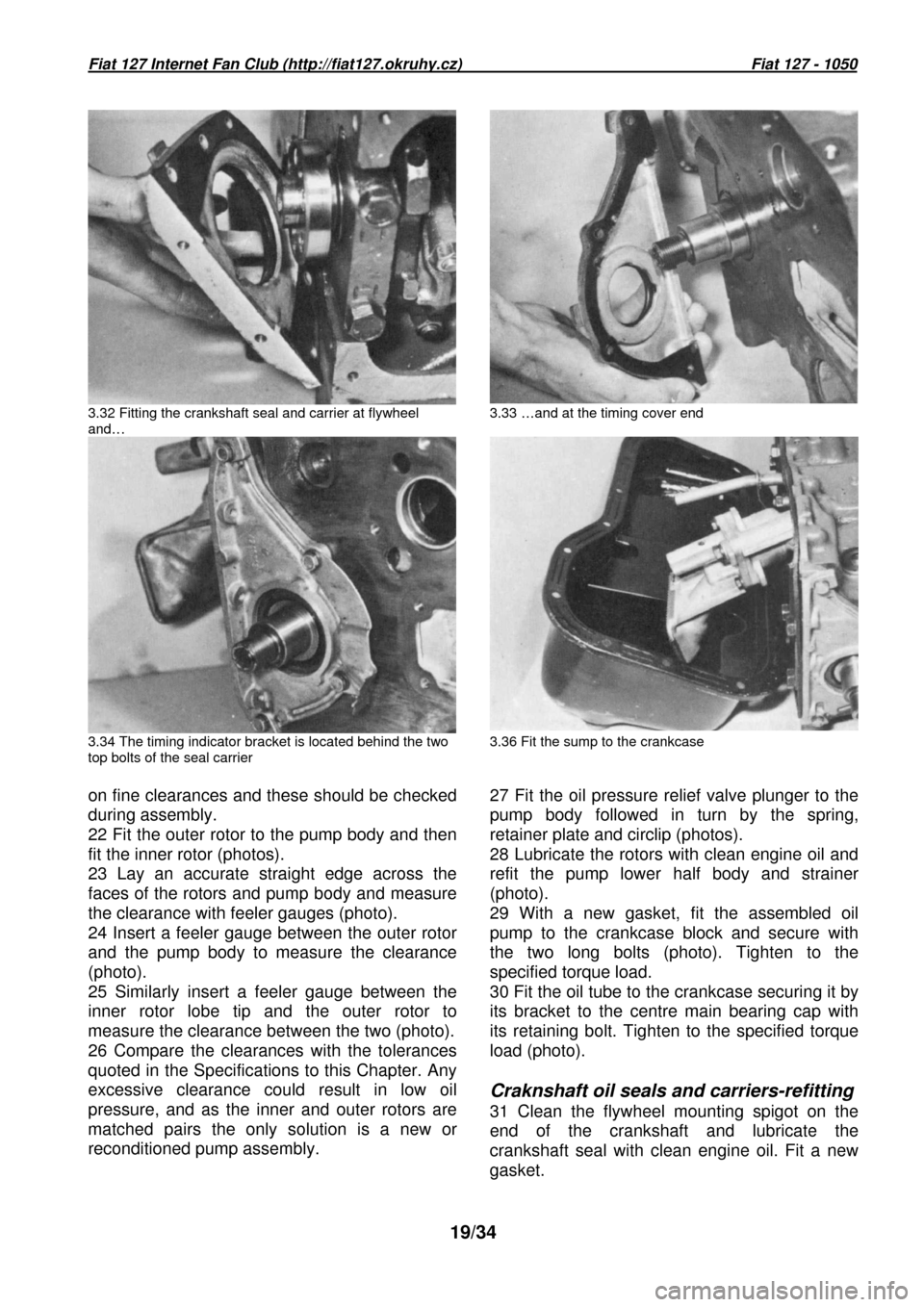
Fiat 127 Internet Fan Club (http://fiat127.okruhy.cz) Fiat 127 - 1050
19/34
3.32 Fitting the crankshaft seal and carrier at fly wheel
and… 3.33 …and at the timing cover end
3.34 The timing indicator bracket is located behind the two
top bolts of the seal carrier 3.36 Fit the sump to the crankcase
on fine clearances and these should be checked
during assembly.
22 Fit the outer rotor to the pump body and then
fit the inner rotor (photos).
23 Lay an accurate straight edge across the
faces of the rotors and pump body and measure
the clearance with feeler gauges (photo).
24 Insert a feeler gauge between the outer rotor
and the pump body to measure the clearance
(photo).
25 Similarly insert a feeler gauge between the
inner rotor lobe tip and the outer rotor to
measure the clearance between the two (photo).
26 Compare the clearances with the tolerances
quoted in the Specifications to this Chapter. Any
excessive clearance could result in low oil
pressure, and as the inner and outer rotors are
matched pairs the only solution is a new or
reconditioned pump assembly. 27 Fit the oil pressure relief valve plunger to th
e
pump body followed in turn by the spring,
retainer plate and circlip (photos).
28 Lubricate the rotors with clean engine oil and
refit the pump lower half body and strainer
(photo).
29 With a new gasket, fit the assembled oil
pump to the crankcase block and secure with
the two long bolts (photo). Tighten to the
specified torque load.
30 Fit the oil tube to the crankcase securing it by
its bracket to the centre main bearing cap with
its retaining bolt. Tighten to the specified torque
load (photo).
Craknshaft oil seals and carriers-refitting
31 Clean the flywheel mounting spigot on the
end of the crankshaft and lubricate the
crankshaft seal with clean engine oil. Fit a new
gasket.
Page 20 of 34

Fiat 127 Internet Fan Club (http://fiat127.okruhy.cz) Fiat 127 - 1050
20/34
3.39 Fitting the auxiliary shaft… 3.40 …and its seal and carrier
3.42 This face of the pulley fits towards the shaft 3.43 Fit the belt tensioner bracket a new gasket to the
block …
3.44 …followed by the spring-loaded plunger… 3.45 …and then the tensioning wheel